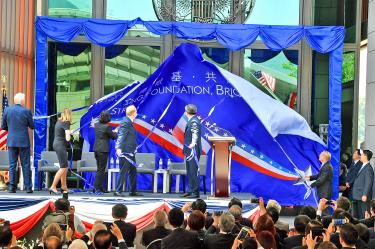Taiwanese and US officials yesterday reiterated their commitment to strengthening bilateral relations as they celebrated the dedication of the American Institute in Taiwan’s (AIT) new office compound in Taipei’s Neihu District (內湖).
President Tsai Ing-wen (蔡英文), former president Ma Ying-jeou (馬英九), Minister of Foreign Affairs Joseph Wu (吳釗燮) and Taipei Mayor Ko Wen-je (柯文哲) topped the list of Taiwanese guests, while US officials included US Assistant Secretary of State for Educational and Cultural Affairs Marie Royce, US Department of State Bureau of Overseas Buildings Operations Principal Deputy Director Ambassador William Moser, US Representative Gregg Harper, AIT Chairman James Moriarty and AIT Director Kin Moy.
Former AIT directors Richard Bush, Raymond Burghardt, William Stanton and Stephen Young also attended.
The compound represents much more than just steel, glass and concrete — it is a symbol of the strength and vibrancy of the Taiwan-US partnership in the 21st century, said Royce, the highest-ranking State Department official to visit Taiwan since then-US assistant secretary of state for economic and business affairs Charles Rivkin in 2015.
“We may be separated by a great ocean, but our shared convictions, values and trust form a strong foundation for cooperation,” Royce said, adding that the AIT’s new home would enable even greater cooperation for many years to come.
Construction of the complex began in 2009 under Ma’s Chinese Nationalist Party (KMT) administration and was completed under Tsai from the Democratic Progressive Party, Moriarty said.
“[It] reflects the support throughout Taiwanese society for close ties with the US,” Moriarty said. “That broad support is mirrored in the US by the wide affection Americans have for Taiwan: across the political aisle, in the executive and legislative branches alike, at all levels of government and throughout American society.”
Reiterating the US’ commitment to its Taiwan Relations Act, Moriarty said that the US would continue to advance bilateral relations, and support Taiwan’s ability to defend itself and make positive contributions to the international community.
Moy said that during his three years as AIT director, he has often said that Taiwan has no better friend than the US.
“As a testament to this friendship, to the US commitment to Taiwan and to our staying power in Taiwan, I offer you this: a tangible symbol that the US is here to stay,” Moy said, referring to the compound that cost Washington US$255.6 million.
Expressing gratitude to all the people who made the building possible, Tsai said she was pleased that through combined efforts, this milestone in the Taiwan-US relationship is now complete.
“The friendship between Taiwan and the US has never been more promising. The great story of Taiwan-US relations remains to be filled with the efforts of those who will one day occupy this building,” she said.
Moriarty, Royce, Tsai, Moser and Moy then pulled on ribbons attached to a curtain covering the building’s main entrance, below a metal US national seal made in the US for the complex.
They placed items into a time capsule to be buried, including a photograph of Tsai and Moy, a copy of documentary filmmaker Chi Po-lin’s (齊柏林) Beyond Beauty: Taiwan From Above (看見台灣), a ceramic plate from former president Lee Teng-hui (李登輝) and calligraphy by Ma.
Prior to the ceremony, Moy dismissed a Wall Street Journal article that cited an anonymous US official as attributing the absence of a senior US Cabinet secretary at the event to Chinese diplomats’ warnings to Washington that such a move would “violate an understanding that Washington should have only unofficial relations with Taiwan.”
“In addition to the chairman of AIT, we also have a special guest: Royce... She is absolutely a perfect candidate, a perfect guest to come here, because she reflects about 40 years of educational and cultural cooperation between both sides,” Moy said.
Moy also shrugged off questions about whether the compound would be guarded by US Marines.
“We do not make political statements with our security. What we do is we bring a sufficient number of people to coordinate with local staff to ensure that the people inside our buildings are very safe,” he said.
Asked about media reports that former AIT deputy director Brent Christensen would succeed Moy, Moriarty did not confirm, but said that Christensen was not only a good friend, but also “a very good friend of Taipei.”
Speaking on the US Senate floor on Monday, senators Cory Gardner and Marco Rubio sent congratulatory messages for the dedication, saying that the new facility shows the strong friendship between the US and Taiwan.
Additional reporting by CNA
Source: Taipei Times - 2018/06/13





















